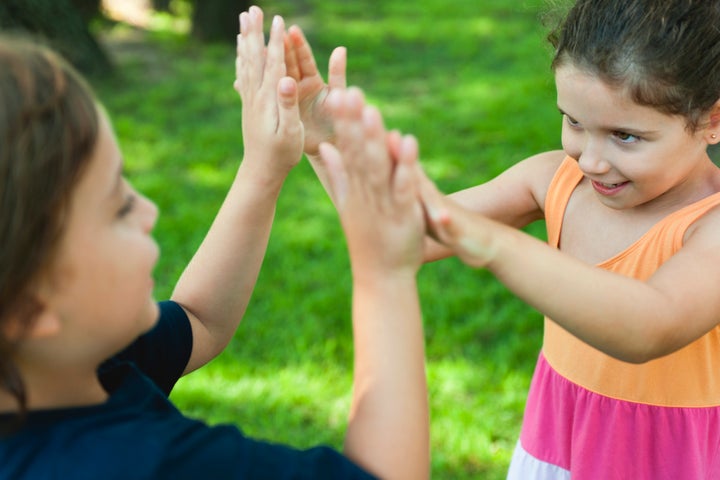
Complex skipping rope twirls, mad-cap running for British bulldog, infinite chant/ clap games: the school playground is a hotbed of imaginative ways to pass break time. Playgrounds may be safely spongy nowadays (no more scabby knees!), but children still love the elaborate ritual and fun of these ideas – as well as taking a big role in learning to make friends.
Nicola Butler, Chair of Play England, says: “Traditional playground games are vital for children’s health, wellbeing and development. Playing these games allows children to learn about friendships (falling out, making up, negotiating and resolving disputes, making the game fun and fair) but most importantly being involved in these games make children happy.”
Tim Gill, a researcher in childhood play, is on the same page. “Traditional outdoor playground games provide children with valuable rehearsals for everyday, adult life and what it means to be an active, engaged, enthusiastic, energetic person,” he says.
“Think about all the tasks that are involved in a game of tag, for instance. Players have to decide who is ‘it’. They have to agree safe spots, and how ‘time out’ works. And they have to sort out disputes about whether or not someone was tagged. The physicality of tag, and indeed many traditional games, demands accurate risk management. When chasing or catching, players have to try to make sure they don’t hurt each other too much, and it’s not a great idea to collide with any non-participants who happen to stray into the area. That is a pretty impressive list of physical, interpersonal and social skills.”
These games have been played for hundreds of years all over the world and need either no equipment or no more than a cheap tennis ball or length of skipping rope. They can be participated in anywhere by all ages and numbers of children and the rules can be endlessly adapted and elaborated on.
Here are a reminder of the starter rules to your favourite, nostalgic games to introduce to your children.

Long rope skipping
Two children hold each ends of the skipping rope and turn it, while other children take turns skipping in and out or all skip at the same time.
Remember this rhyme to jumping the rope, acting out the actions of all the words?
Teddy Bear, Teddy Bear, turn around,
Teddy Bear, Teddy Bear, touch the ground
Teddy Bear, Teddy Bear, show your shoe
Teddy Bear, Teddy Bear, that will do!
Teddy Bear, Teddy Bear, go upstairs
Teddy Bear, Teddy Bear, say your prayers
Teddy Bear, Teddy Bear, turn out the lights
Teddy Bear, Teddy Bear, say good-night!
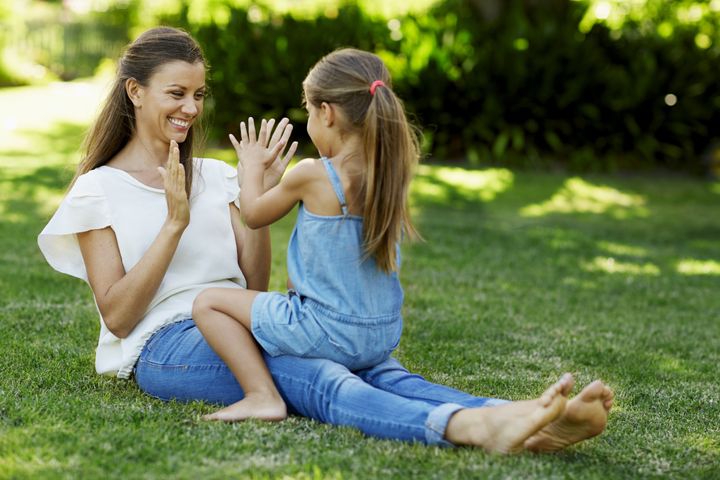
Clapping
The website funclapping.com is a total nostalgia trip with the words to all the clapping songs - plus videos to get you started. The basic clapping rhythm is clap together hands up, hands down, hands to the other person and hands together.
Remember this one?
A sailor went to sea, sea, sea
To see what he could see, see, see
But all that he could see, see, see
Was the bottom of the deep blue sea, sea, sea
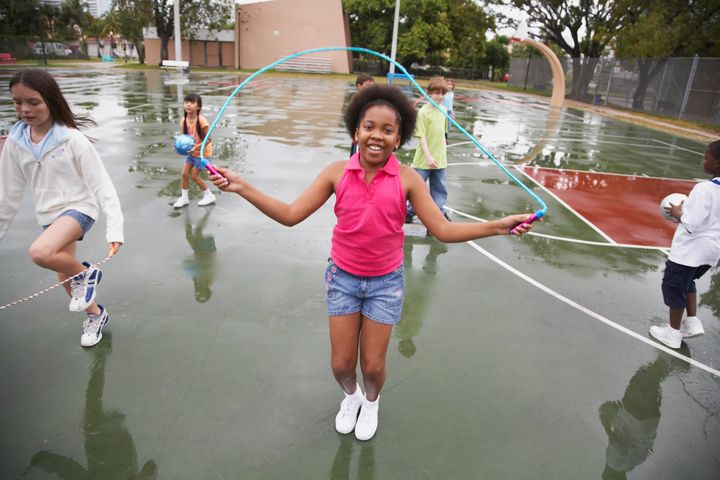
French skipping
You'll need a long piece of elastic, about 2cm wide and 3 metres long. Tie the ends together to make a loop. Two children stand inside the loop so the elastic is stretched taut around their ankles. (If you haven't got enough players, you can use two chairs and their legs.) The third child performs a series of hops and jumps, chanting appropriate rhymes. When finished, the height of the elastic is raised again and again - up to thigh height!
Start with your left foot inside the elastic loop and right foot just outside. Jump over to the other side so your right foot is inside the loop and left foot is outside.
One of the rhymes is:
Chocolate cake, when you bake,
How many minutes will you take?
One, two, three, four
On one: jump up and land with left foot outside the elastic loop and your right foot inside.
On two: jump up and land with both feet together inside the elastic loop.
On three: jump up and land with both feet outside the elastic loop.
On four: jump up and land sideways to the elastic, with your left foot on top of the back elastic and your right foot ahead (in front) of the front elastic.
If the first player fails to execute the correct jump their turn is over and play passes to one of the people inside the circle of elastic.
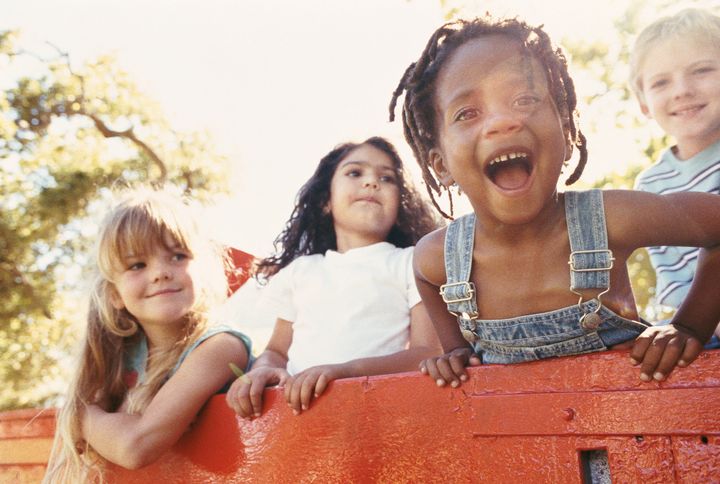
Oranges & Lemons
Two children form an arch with their arms. They decide in secret which of them shall be an 'orange' and which a 'lemon'. All the players sing the Oranges and Lemons song (see below) and the other children take turns to run under the arch until one of them is caught when the arch falls at the end of the song.
The captured player is asked privately whether they will be an 'orange' or a 'lemon' and then goes behind the original 'orange' or 'lemon' team leader.
The game and singing then starts over again. At the end of the game there can be a tug of war to test whether the 'oranges' or 'lemons' are stronger.
Oranges and lemons,
Say the bells of St Clement's.
You owe me five farthings,
Say the bells of St. Martin's.
When will you pay me?
Say the bells of Old Bailey.
When I grow rich,
Say the bells of Shoreditch.
When will that be?
Say the bells of Stepney.
I'm sure I don't know,
Says the great bell at Bow.
Here comes a candle to light you to bed,
Here comes a chopper to chop off your head.
Chip, chop, chip, chop, the last man's head
On the final line, the arch comes down "chopping" one caught player.
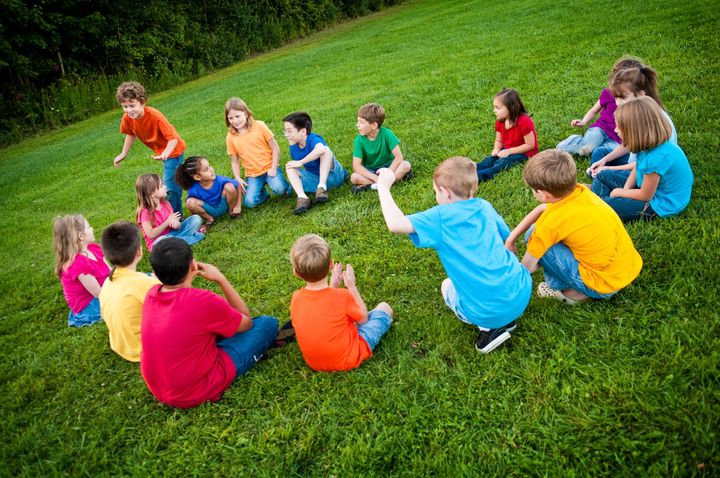
Duck, Duck, Goose
Children sit in a large circle facing inwards. One child is chosen to be the tapper and walks around the outside of the circle, tapping each child on the head whilst saying, "Duck, duck, duck". At some stage she will tap a child and say, "Goose".
The goose then jumps up and chases the tapper around the circle. The tapper in turn tries to get all the way back to the goose's vacated spot, without getting caught.
If the tapper gets home safely, the goose becomes the new tapper and the game starts again. If the goose catches the tapper, the game starts again with the tapper being on again. If the child who's been picked as the goose manages to get back to the space first they can then fold their arms so they are not chosen again.

Please, Mr Crocodile
One child is Mr Crocodile and the other children form a row and say: "Please Mr Crocodile, can we cross your Golden River?"
Mr Crocodile' replies with something like: "Only if you are wearing red".
If you are wearing that colour you can move on one step safely, but if you aren't wearing something red, Mr Crocodile will try and catch/"snap" you while you dodge and run to the safe zone. If you're caught you're out. The first person to reach Mr Crocodile and survive (either by not wearing any of the chosen colours or by not being caught) is the winner and the next Mr Crocodile.
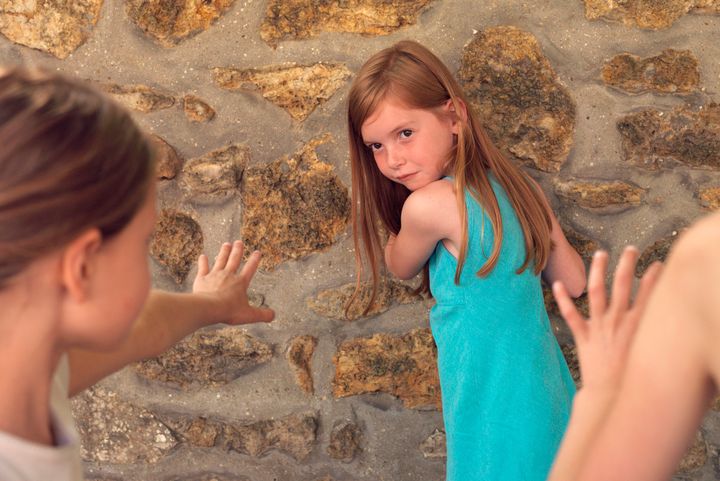
What's The Time, Mr Wolf?
One player is chosen to be Mr Wolf. The other players stand in a line on the opposite end of the playground about 10 to 12 metres away from Mr Wolf. This is 'home'. Mr Wolf stands with his back to them.
The players chant, "What’s the time Mr Wolf?" Mr Wolf replies "two o’clock" (for example). The players advance the same number of steps - two steps for two o'clock. The game continues with different times and resulting steps until Mr Wolf thinks the players are close enough to catch, then when asked the time, he replies, "Dinner time" in his scariest voice, then turns and chases after the scattered players.
The first child caught becomes Mr Wolf. If Mr Wolf does not catch anyone, he has to be Mr Wolf again. If a player reaches Mr Wolf before dinner time, they tap Mr Wolf on the shoulder and run for home. If the player gets home then he is safe but if he is caught then he becomes Mr Wolf.